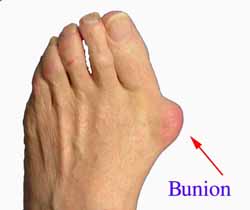Bunions Cause And Effect
Overview
 A bunion (from the Latin 'bunion', meaning enlargement) is a protuberance of bone around the big toe joint. The enlargement can also occur at the outside of the foot, at the base of the little toe. This is called a tailor's bunion or bunionette. As a bunion deformity progresses with time, an enlargement increases in size behind the big toe, making shoe wear difficult and painful. Consequently, the big toe will shift position and move over or under the toes next to the big toe. Bunions can occur at any age between childhood and the golden years. The occurrence of bunions are far more prominent in women than men. Ill fitting narrow shoes and shoes with heels tend to aggravate bunions and cause them to occur at a higher incidence.
A bunion (from the Latin 'bunion', meaning enlargement) is a protuberance of bone around the big toe joint. The enlargement can also occur at the outside of the foot, at the base of the little toe. This is called a tailor's bunion or bunionette. As a bunion deformity progresses with time, an enlargement increases in size behind the big toe, making shoe wear difficult and painful. Consequently, the big toe will shift position and move over or under the toes next to the big toe. Bunions can occur at any age between childhood and the golden years. The occurrence of bunions are far more prominent in women than men. Ill fitting narrow shoes and shoes with heels tend to aggravate bunions and cause them to occur at a higher incidence.
Causes
In most cases, bunions are caused by genetics and incorrect foot mechanics. The foot may flatten too much, forcing the toe joint to move beyond normal range. In some cases, arthritis or an injury produces a bunion. In other cases people are simply born with extra bone near a toe joint. Tight fitting shoes further complicate the condition. Shoes such as high heels are particularly damaging to the toes. These shoes have a sloping foot piece and a narrow toe box. The slope causes the front of the foot to be pushed with force into the narrow toe box. The narrow toe box causes the toes to become squeezed together. Depending on factors such as duration of wearing constraining footwear, skeletal maturity, and individual factors, the toes can be- come permanently adapted to the new position and lead to the formation of a bunion. Once a bunion forms, the mechanics of the feet and toes are altered. Tendons begin to pull the toe into an abnormal position, and the problem tends to progress over time.
Symptoms
With an advanced bunion, the big toe joint can be significantly deformed. The big toe can crowd the other toes and may lie over or under the second toe. The larger the bunion gets, the more it hurts to walk. Wearing any type of shoe can be painful. Symptoms of bunions tend to increase over time as the condition worsens. Typical symptoms include deformity of the big toe joint. Growth of a bony lump (exostosis) at the side of the big toe joint. Pain, redness and tissue swelling (bursitis) over the big toe joint, with thickening of overlying skin. Pain when walking (particularly during the "push off" phase). Overlapping of the big toe above or below the second toe in severe cases.
Diagnosis
Most patients are diagnosed to have bunions from clinical history and examination. However, in some cases, X-rays will be performed to determine the extent of damage to the joint. Furthermore, it will enable the treating doctor to decide on the best course of management of the patient.
Non Surgical Treatment
Non-surgical treatments for bunions may include wearing shoes that fit and that have adequate toe room. Stretching shoes professionally to make them larger. Putting bunion pads over the bunion to cushion the pain. Avoiding activities that cause pain, such as being on your feet for long periods of time. Taking over-the-counter pain relievers when necessary, such as acetaminophen or nonsteroidal anti-inflammatory drugs (NSAIDS) like ibuprofen. Using ice to provide relief from inflammation and pain. Using custom-made orthotic devices. 
Surgical Treatment
Your podiatrist can refer you to a podiatric surgeon who will evaluate the extent of the deformity. A podiatric surgeon can remove the bunion and realign the toe joint in an operation generally referred to as a bunionectomy. However, there are actually around 130 different operations that fall under this title, so don?t presume you?ll need the same type of surgery as that friend of a friend who couldn?t walk for 3 months.
Prevention
If these exercises cause pain, don't overdo them. Go as far as you can without causing pain that persists. This first exercise should not cause pain, but is great for stimulating blood and lymphatic circulation. Do it as often as you can every day. Only do this exercise after confirming it is OK with your doctor. Lie on your back and lift up your legs above you. Wiggle your toes and feet. Eventually you may be able to rapidly shake your feet for a minute at a time. Use your fingers to pull your big toe into proper alignment. Stretch your big toe and the rest of your toes. Curl them under for 10 seconds, then relax and let them point straight ahead for 10 seconds. Repeat several times. Do this at least once a day, and preferably several times. Flex your toes by pressing them against the floor or a wall until they are bent back. Hold them for 10 seconds, then release. Repeat several times. Grip with your toes. Practice picking up an article of clothing with your toes, dropping it, and then picking it up again. Warm water. Soak your feet for 20 minutes in a bowl of warm water. Try doing the foot exercises while soaking, and also relax and rest your feet. Epsom salts. Add it to your warm foot bath soak.